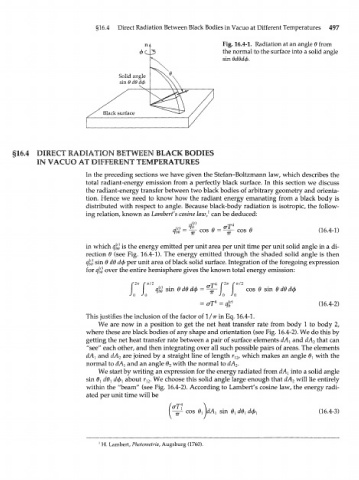Page 517 - Bird R.B. Transport phenomena
P. 517
§16.4 Direct Radiation Between Black Bodies in Vacuo at Different Temperatures 497
Fig. 16.4-1. Radiation at an angle в from
the normal to the surface into a solid angle
sin Ш&ф.
§16.4 DIRECT RADIATION BETWEEN BLACK BODIES
IN VACUO AT DIFFERENT TEMPERATURES
In the preceding sections we have given the Stefan-Boltzmann law, which describes the
total radiant-energy emission from a perfectly black surface. In this section we discuss
the radiant-energy transfer between two black bodies of arbitrary geometry and orienta-
tion. Hence we need to know how the radiant energy emanating from a black body is
distributed with respect to angle. Because black-body radiation is isotropic, the follow-
ing relation, known as Lambert's cosine law) can be deduced:
^
= — cos 0 = r - cos в (16.4-1)
in which q$ is the energy emitted per unit area per unit time per unit solid angle in a di-
rection 0 (see Fig. 16.4-1). The energy emitted through the shaded solid angle is then
q^o sin 0 dO dф per unit area of black solid surface. Integration of the foregoing expression
for qfy over the entire hemisphere gives the known total energy emission:
Г277 Г77/2 j 4 Г2т7 Г7Г/2
щ s m 0 dO dф = —=- cos 0 sin 0 dO dф
Jo Jo Jo Jo
= oT A = qf (16.4-2)
This justifies the inclusion of the factor of l/тг in Eq. 16.4-1.
We are now in a position to get the net heat transfer rate from body 1 to body 2,
where these are black bodies of any shape and orientation (see Fig. 16.4-2). We do this by
getting the net heat transfer rate between a pair of surface elements dA x and dA 2 that can
"see" each other, and then integrating over all such possible pairs of areas. The elements
dA and dA are joined by a straight line of length r , which makes an angle 0 with the
x 2 12 {
normal to dA^ and an angle 0 with the normal to dA .
2
2
We start by writing an expression for the energy radiated from dA into a solid angle
A
sin 0] d0! &ф about r . We choose this solid angle large enough that dA 2 will lie entirely
х
12
within the "beam" (see Fig. 16.4-2). According to Lambert's cosine law, the energy radi-
ated per unit time will be
r 1
r 4
cos sin (16.4-3)
' H. Lambert, Photometria, Augsburg (1760).

